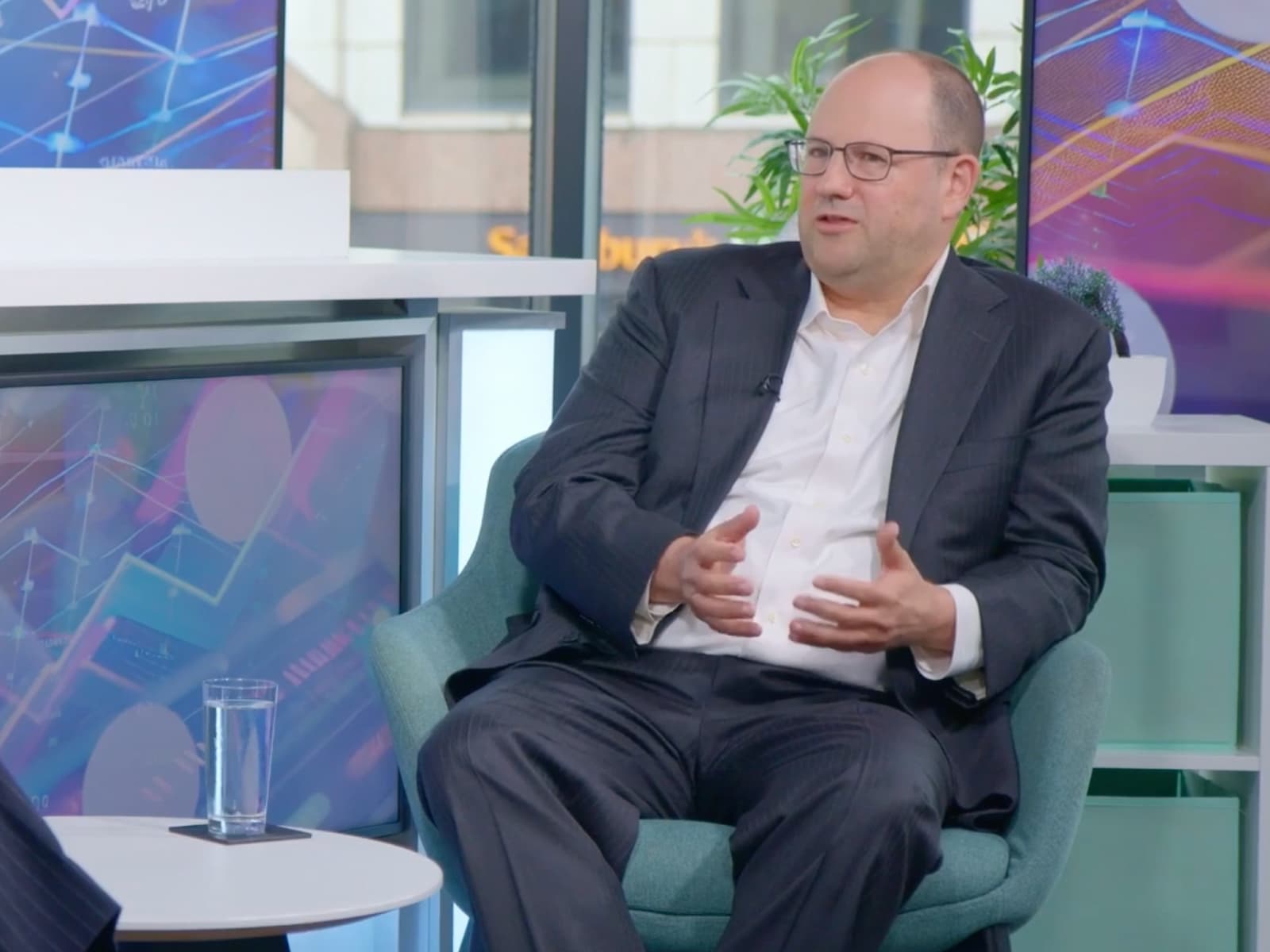Our CIO, Richard Flax, recently discussed the role of technology in investment strategies on Asset TV. He dug deeper into portfolio management and asset allocation at Moneyfarm and shared his view for the next 12 to 18 months. You can watch the full interview here or read the Q&A we picked for you below.
What do you think the future of digital wealth managers is going to be in the UK?
I think that the move towards digital is ongoing. There are some independent players, you’ve seen a lot of activity in the space, you see kind of traditional incumbents trying to find the best way of interacting with clients in whichever way that they choose to do. I think digital will become increasingly the norm for many customers, you will continue to see obviously face-to-face advice be relevant but for those people who can’t afford, or perhaps don’t want face-to-face advice, the digital solution will become increasingly relevant.
What do you think the future of active management is? Because we go through these huge pyramids, there has been a lot more indexation, an explosion in the number of ETFs…
I feel that the distinction between active and passive is a little bit overplayed. What really clients care about is the net return after fees that they get. Now it happens that the combination of a market cap weighted instrument and ETF in this case and relatively low fees has been a pretty compelling proposition over the last decade or so. And we’ve seen the flows reflect that, but active management probably does still have a role, not least in terms of price discovery, but it’s a challenge for active managers and that challenge they have to be able to prove the value that they bring and you’ve seen fees begin to come down in the space. Over time there’s probably more of that to go but for active managers who can prove that they can provide a net return that is better than a passive option there should clearly be a role for them, it’s just a difficult thing to do and it’s a difficult thing for clients and fund selectors to find those managers a priori.
In terms of your overall proposition I think it’s based very much on the philosophy that the bulk of returns comes from asset allocation rather than stock or fund selection. Tell us a little bit about how you go about allocating assets, how different from your peers might you be on that.
From an asset allocation perspective we would argue that we’re not doing things that are surprising. We’re definitely trying to provide an institutional-style experience, an institutional-style process, in terms of how we’re thinking about the asset allocation. When we think about the implementation of those views we have historically used ETFs and passive instruments, but there’s a very broad range of instruments available and you can generally find ways to get particular exposures that you want. There are a few active ETFs around, it’s beginning to gain a little bit of traction in the US and perhaps will do so in Europe over time. We haven’t used them so far, we have for instance used Factor ETFs, Regional ETFs, Value or Small cap. There are a lot of ways using passive instruments to get different types of exposure. It’s not simply a question of ‘give me a market cap weighted ETF for the whole world’ and that’s where we leave it. So you can get those exposures without necessarily going down the route of ‘I want to pick a single stock’ or ‘I want to generate alpha from stock selection rather than factor or country or region’.
When you’re looking at your asset allocation, what are the timeframes you’re looking out over? How would you distinguish between a strategic view and a tactical view?
The strategic asset allocation process that we run every year tries to take it ten years. Time frame tactical we’re thinking about 12 to 18 months, but generally speaking we are trying to take longer time frames, we’re trying to keep our turnover relatively low then perhaps what we see from peers elsewhere.
When you take a ten year view, how easy is it to do that? What gives you some certainty rather than you sort of sit there and think well, it’s great but fundamentally this is just futurology, we’ve no idea how demographics will play out over ten years or where China will be or Russia.
A couple of things. I think that the 10-year perspective obviously is a challenging one but in some ways it’s easier than thinking about the next six to nine months and because you can say what really will matter in the long term, will be the starting valuation and some assumption about what economic activity will do. So easy to say and not necessarily so easy to think about in all the things that you describe there really begin to come into play so what happens to demographics and the impact that has on economic growth, how does Chinese demand kind of play out in terms of economic activity. The other part of those two- if you think about starting valuations and economic growth- is the interaction between economic activity and corporate profitability, particularly if you’re thinking about equities. There’s an implicit assumption there about what will happen to corporate earnings and if you think about the last 10 years, what mattered there to some extent was that you didn’t see great economic growth but actually corporate earnings or corporate profitability as a proportion of the overall GDP generally drifted higher, you saw margins drift higher and so you can actually got more bang for your buck from an earnings perspective than you might have expected simply looking at economic activity. When you think about the strategic perspective it’s about trying to strip it down to the barest essentials and obviously having the humility to understand that you don’t know and you’re trying to create a picture, that’s really where the portfolio construction comes in, and not to take a too aggressive view in any particular direction.
What are your implicit assumptions you’re making about the UK stock market over a 10 year view as we’re sat here today- Q3 2024?
Let’s break it down in strategic terms. Starting valuations look relatively attractive versus history, economic activity doesn’t look particularly robust. You could reasonably say, if you think about the composition of UK equities, they have much more of a global bias but they also have some sector biases as well that you need to factor into, so there’s a little bit of tension between the starting valuation and the outlook for corporate earnings and corporate profitability. When we think about it, we have obviously exposure to UK equities, we don’t have a huge exposure versus perhaps the UK wealth manager but that’s more about the home country bias of some of our peers than it is a reflection of necessarily our view. This is drifted lower over time so if you think about 10 or 15 years, UK wealth managers are generally quite exposed to UK assets and have generally reduced those exposures over time as global markets have expanded.
Can you talk us through one of your tactical asset allocation calls at the moment? What’s something you’re looking at over a 12 to 18 month period?
There are a couple of big questions that we constantly wrestle with. One is around tech and Us exposure, more generally Us equities have become an increasingly large percentage of the global equity universe. One of the challenges with the market cap weighted approaches is to what extent you follow that Us equity exposure is higher, and we still obviously have a lot of Us equity exposure but perhaps we haven’t followed the market cap weighted as mechanically as some might. The second point is really around duration, the outlook for interest rates and inflation going forward. One of the questions there is to what extent, as interest rates likely begin to come down, will we see inflation re-accelerate, will we see inflation continue to drift lower, will we go back to a world that is a little bit closer to what we saw in the kind of pre-2022 experience or will we be thinking about a world where Us 10-year yields are in the 3.5% to 4% range are kind of normal range. So thinking about not just what happens in the next six to nine months in regard to monetary policy, but really the second order effects of what happens to long-term yields and inflation as we enter an easing cycle. These are some of the challenges that we continue to debate.
Going back to the States, one of the things that’s been driving is very large tech companies and you’ve mentioned to have slight underweight to the Us given how rapid it is growing. What do you do on the tech side? Do you have a slightly lower tech waiting? Do you have a bit more of a bias to smaller cap Us technology? You like the trend but you’re a bit worried about the valuations at the top?
Where we are today, and we obviously have the flexibility to choose and the ETF universe gives you the opportunity to do that, we’ve typically taken a Us exposure simply through S&P500 exposure. We have some small cap exposure in some model portfolios but not a huge amount. We haven’t taken the more targeted approach of taking for instance pure NASDAQ exposure or something even more concentrated. We’ve taken a fairly broad approach and the S&P 500, given the nature of it and the composition of it, has given us a good amount of tech exposure without taking on some of that very targeted risks that might add a lot more volatility to the portfolios. Sometimes that’s been right and sometimes you would have been better off with hindsight just having a kind of a much tighter exposure, but typically our approach has been to take a relatively broad, well diversified approach and use that as your core building block.
How easy is it to create a personalised investment option? Can you ultimately say that clients will sit in one of four or five models? Everyone’s got their own individual needs and barriers. Can technology overcome all of that?
I think the technology can overcome all of those. The question is not whether it can but whether it should. We have the core model portfolios, where most of our clients are, and you have a classic version and an Esg version – which again is to your point where clients have particular values or beliefs we try and cater to that. We also have some satellite baskets that clients can use, and we think about the risk of the total exposure, but those satellite baskets on things like technology or sustainability give clients the opportunity to customise their portfolios within some parameters, so we aren’t necessarily allowing the customer to say ‘I want to pick this stock’. That’s a different proposition but we do give the clients the core multi-asset exposure at a low cost that we think should be the core building block for an investment proposition, and we also give some opportunity to customise in terms of satellite baskets, in terms of some money market offerings that really give the client the opportunity to round out their exposures where they would like to.
I was looking at the performance of your investment models since launch on your website, the two lowest risk portfolios appear to have underperformed their peers since launch, while everything else seems to be outperforming. What’s going on in the bond world at Moneyfarm?
We’ve done relatively well on the mid to high-risk portfolios which is the vast majority of where our assets sit. On the fixed income side, when we look at the peer group and we’ve explored it with the provider, which is ARC, our understanding is it’s a smaller peer group firstly but also that is a peer group that use more alternatives and some of the alternatives have it seems performed relatively well, so when you think about the the impact of rising yields in 2022 and 2023 the ARC universe actually held up fairly well, we think that’s a function of some of that alternative exposure that we typically wouldn’t use.
Where do you see Moneyfarm in three years time or where would you like it to be?
I think Moneyfarm is a business about scale, it’s about using technology to provide great outcomes for customers so I would like to see Moneyfarm continue to grow. Grow in terms of assets, in terms of the products that we offer our customers and also in terms of the services. I think it’s about scaling up that business, improving the profitability metrics and really showing that the digital solution is a really powerful one for a pretty broad segment of the population.
*As with all investing, financial instruments involve inherent risks, including loss of capital, market fluctuations and liquidity risk. Past performance is no guarantee of future results. It is important to consider your risk tolerance and investment objectives before proceeding.





